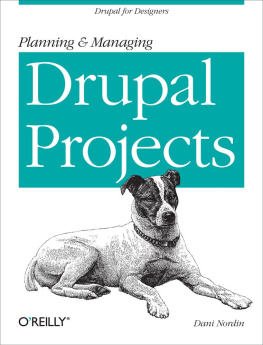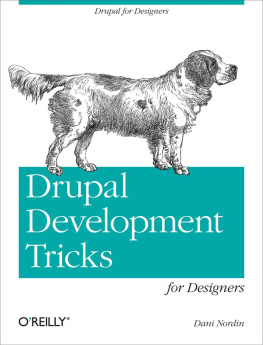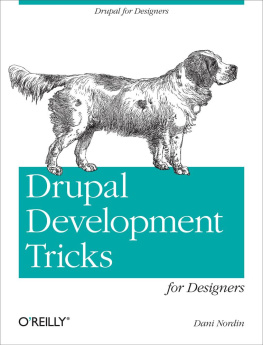Planning and Managing Drupal Projects
Dani Nordin
Beijing Cambridge Farnham Kln Sebastopol Tokyo
Preface
If youre reading this book, youre probably a web designer who has heard of Drupal, wants to get started with it, and may have even tried it out a couple of times. And you might be frustrated because even if youre used to code, Drupal has thrown you a major learning curve that you hadnt expected. And just when you think youve gotten a basic site together, now you have to figure out how to make it look rightand the whole process starts over again.
Yep, Ive been there too. Thats why I wrote this book.
This book is for the solo site builder or small team thats itching to do interesting things with Drupal, but needs a bit of help understanding how to set up a successful Drupal project. Its for the designer who knows HTML and CSS, but doesnt want to have to learn how to speak developer in order to parse Drupal documentation. Most importantly, this book is for those who want to use Drupal to make their vision a reality, but need help working their minds around the way that Drupal handles design challenges.
Contents of This Book
What I present here are not recipes for specific use cases; although recipes can be useful, experience has shown theres rarely just one way to accomplish an objective in Drupal. Rather, what Im offering is context: a way of understanding what Drupal is and how it works, so that you can get over the hump and start figuring things out on your own.
This book, Planning and Managing Drupal Projects, is part of a three-part series (look for Design and Prototyping for Drupal and Development Tricks for Drupal Designers , coming soon). Over the course of this series, collectively titled Drupal for Designers , Ill help you understand:
How to plan and manage Drupal projects successfully (in the Planning and Managing guide);
How to more effectively create visual design for Drupal by understanding what Drupal is spitting out (in Design and Prototyping );
How to break down your design layouts to turn them into Drupal themes (in Design and Prototyping );
How to get started with version control, Drush, and other ninja-developer Drupal Magick that can make your life much easier working with Drupal (in Development Tricks for Drupal Designers ).
In this first volume, Planning and Managing Drupal Projects , well look at the typical lifecycle of a Drupal project, with a focus on the early stages of planning a site. You will learn:
How to understand what Drupal is doing under the hood, including some basic terms you should know;
The lifecycle of a typical Drupal project;
How to get the information you need to effectively plan, estimate and manage a Drupal project;
Techniques for framing the design challenge and dealing with the User Experience layer;
Why you should always get real content for the project as early as possible;
How to choose the right modules for your project (along with some of my favorite modules);
How to walk clients through the Drupal design and development process.
A Caveat
The goal of this guide isnt to teach specific project management techniques. Every Drupal team and site builder has their own approach to creating projects, and its hard to pin down one right way to create in Drupal. The key to appropriate planning, then, is:
Knowing what you have to create . This is where the site planning and discovery process, discussed in , is especially useful.
Knowing what youll need to do in order to get the job done . This will vary depending on the project, but there are some important factors to consider in .
Knowing how to walk clients through the process . In , I share some of my experience from years of working with clients, including proposing and estimating projects, handling difficult conversations, and creating effective documentation.
In the last chapter, I share some of the client documentation Ive developed over six years of running a design studio and estimating Drupal projects. The content is available under Creative Commons, so you are free to use and adapt it as you like.
Conventions Used in This Book
The following typographical conventions are used in this book:
ItalicIndicates file names, directories, new terms, URLs, clickable items in the interface such as menu items and buttons, and emphasized text.
Constant widthIndicates parts of code, contents of files, commands, and output from commands.
Constant width italicIndicates user input.
Note
This icon signifies a tip, suggestion, or general note.
Warning
This icon indicates a warning or caution.
Using Code Examples
This book is here to help you get your job done. In general, you may use the code in this book in your programs and documentation. You do not need to contact us for permission unless youre reproducing a significant portion of the code. For example, writing a program that uses several chunks of code from this book does not require permission. Selling or distributing a CD-ROM of examples from OReilly books does require permission. Answering a question by citing this book and quoting example code does not require permission. Incorporating a significant amount of example code from this book into your products documentation does require permission.
We appreciate, but do not require, attribution. An attribution usually includes the title, author, publisher, and ISBN. For example: Planning and Managing Drupal Projects by Dani Nordin. Copyright 2011 OReilly Media, Inc., 978-1-449-30548-2.
If you feel your use of code examples falls outside fair use or the permission given above, feel free to contact us at .
Safari Books Online
Note
Safari Books Online is an on-demand digital library that lets you easily search over 7,500 technology and creative reference books and videos to find the answers you need quickly.
With a subscription, you can read any page and watch any video from our library online. Read books on your cell phone and mobile devices. Access new titles before they are available for print, and get exclusive access to manuscripts in development and post feedback for the authors. Copy and paste code samples, organize your favorites, download chapters, bookmark key sections, create notes, print out pages, and benefit from tons of other time-saving features.
OReilly Media has uploaded this book to the Safari Books Online service. To have full digital access to this book and others on similar topics from OReilly and other publishers, sign up for free at http://my.safaribooksonline.com.
How to Contact Us
Please address comments and questions concerning this book to the publisher:
| OReilly Media, Inc. |
| 1005 Gravenstein Highway North |
| Sebastopol, CA 95472 |
| 800-998-9938 (in the United States or Canada) |
| 707-829-0515 (international or local) |
| 707-829-0104 (fax) |
We have a web page for this book, where we list errata, examples, and any additional information. You can access this page at:













